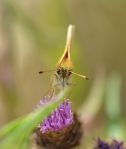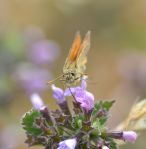It is now high summer and countless millions of butterflies fill the countryside. Four familiar groups are absolutely everywhere. The common brown species of any grassy place or woodland are being joined on the wing by second brood whites and new brood Vanessids produced by the early season hibernators. And darting about amongst all of these are the diminutive, moth-like brown Skippers: Large, Small and Essex.
I know of two reliable Oxon locations for the enigmatic Essex Skipper: Hagbourne railway embankment (SU622894) and Burgess Field nature park in North Oxford (SU497087). Having been alerted by Adam to their emergence at the second one I went to check it out on Friday afternoon. The first brown Skipper I came across in this landfill regeneration site was indeed an Essex and thereafter the long grass and many wildflowers here sported hundreds of them.
Though a relatively common species in south-eastern England, Essex is very similar to Small Skipper and hence easily overlooked in the field by experienced and less savvy observers alike. That is unless one wishes to get down on all fours and examine the antennae of every brown skipper encountered.
So here is the Rn’S identification guide to brown Skippers. Most people new to butterflying know that Essex Skipper has inky black tips to the antennae. But Large Skipper have black undersides to their antennae and so are easily confused with Essex depending on the angle from which they are viewed. The key difference is that Large Skipper antennae are hooked at the ends, as the central picture below shows. Small Skipper antennae are golden brown on the top sides and so easier to distinguish.
- Essex Skipper
- Large Skipper
- Small Skipper
I had this lesson a few seasons ago from Butterfly Conservation’s former Upper Thames Branch and now national chair Dr Jim Asher. He said the surest way to separate Essex Skipper is to view them head on, as the outside pictures demonstrate. Turned off? Well it’s no worse to me than expert birders banging on about tertiaries, scapulars and greater ear coverts.





